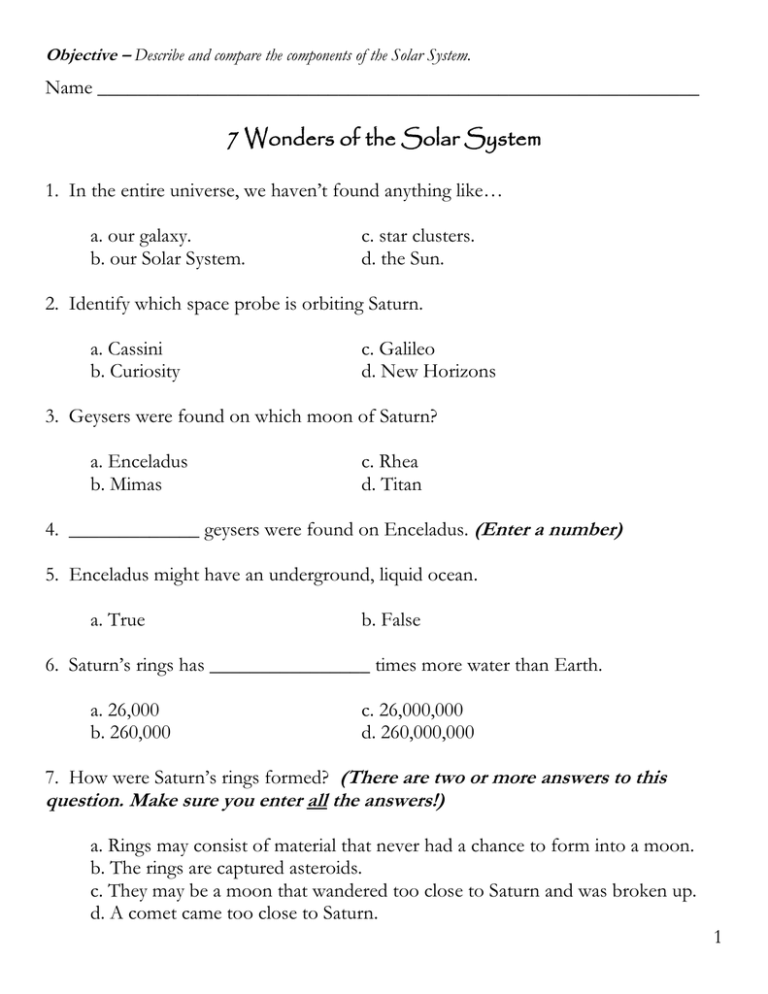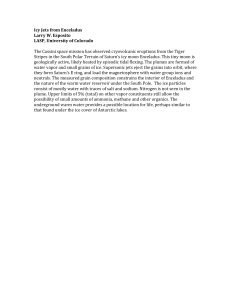7 Wonders of the Solar System
advertisement

Objective – Describe and compare the components of the Solar System. Name ____________________________________________________________ 7 Wonders of the Solar System 1. In the entire universe, we haven’t found anything like… a. our galaxy. b. our Solar System. c. star clusters. d. the Sun. 2. Identify which space probe is orbiting Saturn. a. Cassini b. Curiosity c. Galileo d. New Horizons 3. Geysers were found on which moon of Saturn? a. Enceladus b. Mimas c. Rhea d. Titan 4. _____________ geysers were found on Enceladus. (Enter a number) 5. Enceladus might have an underground, liquid ocean. a. True b. False 6. Saturn’s rings has ________________ times more water than Earth. a. 26,000 b. 260,000 c. 26,000,000 d. 260,000,000 7. How were Saturn’s rings formed? (There are two or more answers to this question. Make sure you enter all the answers!) a. Rings may consist of material that never had a chance to form into a moon. b. The rings are captured asteroids. c. They may be a moon that wandered too close to Saturn and was broken up. d. A comet came too close to Saturn. 1 Objective – Describe and compare the components of the Solar System. 8. There are _____________ moons embedded in Saturn’s rings. (Enter a number) 9. This is three times the size of Earth. a. The Great Blue Spot b. The Great Black Spot c. The Great Red Spot d. The Great White Spot 10. This storm has been going strong for _____________ years. (Enter a number) 11. The Great Red Spot is not shrinking. a. True b. False 12. This is found between Mars and Jupiter. a. Asteroid Belt b. Asteroid Cloud c. Kuiper Belt d. Oort Cloud 13. Asteroids did not form a planet because… (There are two answers to this question. Make sure you enter all the answers!) a. of Jupiter’s gravitational pull. b. there wasn’t enough material to form a planet. c. there was a planet, but it blew up forming the Asteroid belt. d. the gravitational pull of all the planets. 14. If you took all the asteroids in the Asteroid Belt and put them together, the world would be smaller than… a. Enceladus. b. Mercury. c. the Moon. d. Pluto. 15. Hollywood does not accurately portray the Asteroid Belt. a. True b. False 2 Objective – Describe and compare the components of the Solar System. 16. The average distance between asteroids is _____________ miles. a. 1,000 b. 10,000 c. 100,000 d. 1,000,000 17. Near Earth Objects are rocks like asteroids and comets that strike earth every day. a. True b. False 18. This is the largest volcano in the Solar System. a. Elysium Mons b. Mauna Kea c. Tharsis Ridge d. Olympus Mons 19. The Sun’s surface is an ocean of _____________ o F. plasma. (Enter a number. Leave out the comma.) 20. The Sun’s visible surface is called the… a. chromosphere. b. corona. c. photosphere. d. radiative envelope. 21. A coronal mass ejection sends a large amount of x-rays to Earth. Why don’t the xrays affect us? a. They travel too slowly. b. Our atmosphere absorbs most x-rays coming from coronal mass ejections. c. They weaken as they travel towards Earth. d. Our atmosphere reflects the x-rays into space. 3 Objective – Describe and compare the components of the Solar System. 7 Wonders of the Solar System – Key 1. In the entire universe, we haven’t found anything like… a. our galaxy. b. our Solar System. c. star clusters. d. the Sun. b. our Solar System. 2. Identify which space probe is orbiting Saturn. a. Cassini b. Curiosity c. Galileo d. New Horizons a. Cassini 3. Geysers were found on which moon of Saturn? a. Enceladus b. Mimas c. Rhea d. Titan a. Enceladus 4. _____________ geysers were found on Enceladus. (Enter a number) 30 5. Enceladus might have an underground, liquid ocean. a. True b. False a. True (2 choices) 6. Saturn’s rings has ________________ times more water than Earth. a. 26,000 b. 260,000 c. 26,000,000 d. 260,000,000 4 Objective – Describe and compare the components of the Solar System. c. 26,000,000 7. How were Saturn’s rings formed? (There are two or more answers to this question. Make sure you enter all the answers!) a. Rings may consist of material that never had a chance to form into a moon. b. The rings are captured asteroids. c. They may be a moon that wandered too close to Saturn and was broken up. d. A comet came too close to Saturn. a. Rings may consist of material that never had a chance to form into a moon; c. They may be a moon that wandered too close to Saturn and was broken up; d. A comet came too close to Saturn. 8. There are _____________ moons embedded in Saturn’s rings. (Enter a number) 62 9. This is three times the size of Earth. a. The Great Blue Spot b. The Great Black Spot c. The Great Red Spot d. The Great White Spot c. The Great Red Spot 10. This storm has been going strong for _____________ years. (Enter a number) 400 11. The Great Red Spot is not shrinking. a. True b. False b. False (2 choices) 12. This is found between Mars and Jupiter. 5 Objective – Describe and compare the components of the Solar System. a. Asteroid Belt b. Asteroid Cloud c. Kuiper Belt d. Oort Cloud a. Asteroid Belt 13. Asteroids did not form a planet because… (There are two answers to this question. Make sure you enter all the answers!) a. of Jupiter’s gravitational pull. b. there wasn’t enough material to form a planet. c. there was a planet, but it blew up forming the Asteroid belt. d. the gravitational pull of all the planets. a. of Jupiter’s gravitational pull; d. the gravitational pull of all the planets. 14. If you took all the asteroids in the Asteroid Belt and put them together, the world would be smaller than… a. Enceladus. b. Mercury. c. the Moon. d. Pluto. c. the Moon 15. Hollywood does not accurately portray the Asteroid Belt. a. True b. False a. True (2 choices) 16. The average distance between asteroids is _____________ miles. a. 1,000 b. 10,000 c. 100,000 d. 1,000,000 d. 1,000,000 6 Objective – Describe and compare the components of the Solar System. 17. Near Earth Objects are rocks like asteroids and comets that strike earth every day. a. True b. False a. True (2 choices) 18. This is the largest volcano in the Solar System. a. Elysium Mons b. Mauna Kea c. Tharsis Ridge d. Olympus Mons d. Olympus Mons 19. The Sun’s surface is an ocean of _____________ o F. plasma. (Enter a number. Leave out the comma.) 10000 20. The Sun’s visible surface is called the… a. chromosphere. b. corona. c. photosphere. d. radiative envelope. c. photosphere. 21. A coronal mass ejection sends a large amount of x-rays to Earth. Why don’t the xrays affect us? a. They travel too slowly. b. Our atmosphere absorbs most x-rays coming from coronal mass ejections. c. They weaken as they travel towards Earth. d. Our atmosphere reflects the x-rays into space. b. Our atmosphere absorbs most x-rays coming from coronal mass ejections. 7 Objective – Describe and compare the components of the Solar System. 7 Wonders of the Solar System – Scoring Guide 20-21 – 4 18-19 – 3.5 15-17 – 3 13-14 – 2.5 11-12 – 2 9-10 – 1.5 8–1 1-7 – .5 8



